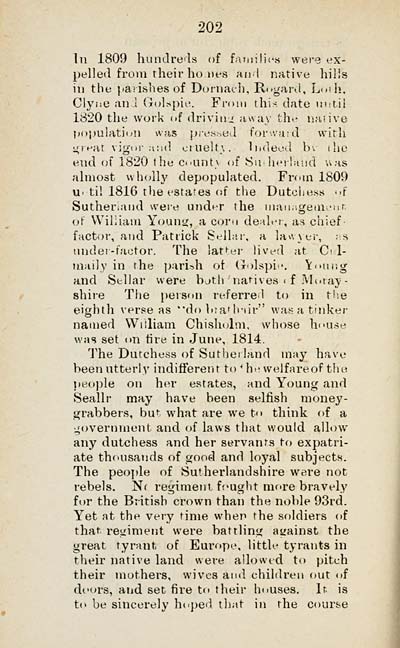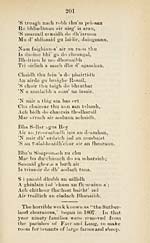Download files
Complete book:
Individual page:
Thumbnail gallery: Grid view | List view

202
111 1809 hunJre<ls of fat. ii lies were ex-
pelled from their ho nes ani native hills
iij the |»a!Ìsliesof Dornaeh, Rogard, L(»ih,
Clyne an .1 Goh-spie. From thi< date iintii
1820 the work of drivirii away the nniive
};opulati<ni was pressed forward with
i^rHjit vigoi- ;i!id ciue]t_\. Indeed hv ihe
end of 1820 the cunt V of Sndieiland uas
ahnost wholly depopulated. From 1809
U' til 1816 the estares of the Dutchess of
Sutherland were und^•r the uiauageai^Mir
ot Wiliiam Young;, a corn dealer, as chief-
factor, and Patiick Selhii-, a lav\\Li', ■■ s
under-factor. The latter lived at C: 1-
maily in the pari.->h of (roLspi'. Vniiig
and Stllar were bjth natives < f Motaj; -
shije The person referre 1 to in t!ie
eighth verse as "do l.ia'lriir" wasa tinker
named William Chish(jlni, whose house
was set on tire in June, 1814.
The Dutchess of Sutherland may have
been utterly indifferent to ^ hi- welfareof the
peo))le on her estates, and Young and
Seallr may have been selfish money-
grabbers, bu^ what are we t<» think of a
.government and of laws that would allow
any dutchess and her servants to expatri-
ate thousands of good and loyal subjects.
The peo])le of Sutherlandshire were not
rebels. Nr regiment fought more bravely
for the British crown than the noble 93rd.
Yet at the very time when the soldiers of
that res^iiment were battling ayainst the
great tyrant of Europe, little tyrants in
their native land were allowed to pitch
their mothers, wives ami children out of
doors, and set fire to their houses. Ir- is
t(* be sincerely hoped that in the course
111 1809 hunJre<ls of fat. ii lies were ex-
pelled from their ho nes ani native hills
iij the |»a!Ìsliesof Dornaeh, Rogard, L(»ih,
Clyne an .1 Goh-spie. From thi< date iintii
1820 the work of drivirii away the nniive
};opulati<ni was pressed forward with
i^rHjit vigoi- ;i!id ciue]t_\. Indeed hv ihe
end of 1820 the cunt V of Sndieiland uas
ahnost wholly depopulated. From 1809
U' til 1816 the estares of the Dutchess of
Sutherland were und^•r the uiauageai^Mir
ot Wiliiam Young;, a corn dealer, as chief-
factor, and Patiick Selhii-, a lav\\Li', ■■ s
under-factor. The latter lived at C: 1-
maily in the pari.->h of (roLspi'. Vniiig
and Stllar were bjth natives < f Motaj; -
shije The person referre 1 to in t!ie
eighth verse as "do l.ia'lriir" wasa tinker
named William Chish(jlni, whose house
was set on tire in June, 1814.
The Dutchess of Sutherland may have
been utterly indifferent to ^ hi- welfareof the
peo))le on her estates, and Young and
Seallr may have been selfish money-
grabbers, bu^ what are we t<» think of a
.government and of laws that would allow
any dutchess and her servants to expatri-
ate thousands of good and loyal subjects.
The peo])le of Sutherlandshire were not
rebels. Nr regiment fought more bravely
for the British crown than the noble 93rd.
Yet at the very time when the soldiers of
that res^iiment were battling ayainst the
great tyrant of Europe, little tyrants in
their native land were allowed to pitch
their mothers, wives ami children out of
doors, and set fire to their houses. Ir- is
t(* be sincerely hoped that in the course
Set display mode to: Large image | Transcription
Images and transcriptions on this page, including medium image downloads, may be used under the Creative Commons Attribution 4.0 International Licence unless otherwise stated. ![]()
| Early Gaelic Book Collections > Blair Collection > Comhchruinneachadh Ghlinn-a'-Bhaird > (218) |
|---|
| Permanent URL | https://digital.nls.uk/76041402 |
|---|
| Description | A selection of books from a collection of more than 500 titles, mostly on religious and literary topics. Also includes some material dealing with other Celtic languages and societies. Collection created towards the end of the 19th century by Lady Evelyn Stewart Murray. |
|---|
| Description | Selected items from five 'Special and Named Printed Collections'. Includes books in Gaelic and other Celtic languages, works about the Gaels, their languages, literature, culture and history. |
|---|

